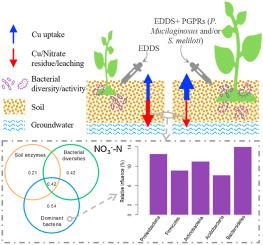Chemosphere ( IF 8.1 ) Pub Date : 2021-09-18 , DOI: 10.1016/j.chemosphere.2021.132288 Wenliang Ju 1 , Chengjiao Duan 2 , Lei Liu 3 , Xiaolian Jin 2 , Gabriela Bravo-Ruiseco 3 , Yuxia Mei 4 , Linchuan Fang 5

|
Biodegradable chelant (S,S)–N,N′-ethylenediaminedisuccinic acid (EDDS) has the more advantages of enhanced metal mobility, rapid degradation, environmental friendliness, and ammonium release. However, the risk of metal and/or nitrate residues and leaching within EDDS biodegradation remains as the bottleneck for the widespread application of EDDS-induced phytoremediation. This study aims to explore if the inoculation of plant growth-promoting rhizobacteria (PGPRs) can eliminate the risk associated with the short-term application of EDDS by investigating Cu phytoextraction and soil nitrate content. Results showed that EDDS application significantly increased the copper (Cu) concentration in shoots, soil total Cu, NH4+-N and NO3−-N content, but decreased plant biomass. The inoculation of PGPRs in the soil showed a strong ability to increase plant biomass, Cu phytoextraction and soil NH4+-N content, and decrease soil Cu and NO3−-N content. Moreover, bacterial dominant taxa were found to be the largest contributors to soil NH4+-N and NO3−-N variation, and the abundance of denitrifying bacteria (Bacteroidetes and Stenotrophomonas) decreased in the treatment with PGPRs. The risk of residual Cu and nitrate leaching was reduced by the inoculation of PGPRs without significantly changing the stability of the bacterial community. These new findings indicate that the exogenous application of beneficial rhizobacteria can provide an effective strategy to reduce the risk in metal-contaminated soils of chelant-assisted phytoextraction.
中文翻译:

通过外源接种促进植物生长的根际细菌,降低与 EDDS 增强的植物提取过程相关的铜和硝酸盐浸出风险
可生物降解螯合剂(S,S)-N,N'-乙二胺二琥珀酸(EDDS)具有增强金属迁移率、快速降解、环境友好和释放铵等优点。然而,EDDS 生物降解过程中金属和/或硝酸盐残留和浸出的风险仍然是 EDDS 诱导植物修复广泛应用的瓶颈。本研究旨在通过调查铜植物提取物和土壤硝酸盐含量来探索接种植物促生长根际细菌 (PGPRs) 是否可以消除与短期施用 EDDS 相关的风险。结果表明,EDDS 施用显着增加了枝条中的铜 (Cu) 浓度、土壤总铜、NH 4 + -N 和 NO 3 --N 含量,但降低了植物生物量。在土壤中接种PGPRs表现出很强的增加植物生物量、Cu植物提取和土壤NH 4 + -N含量,降低土壤Cu和NO 3 - -N含量的能力。此外,发现细菌优势分类群是土壤 NH 4 + -N 和 NO 3 - -N 变异的最大贡献者,以及反硝化细菌(拟杆菌和窄养单胞菌)的丰度) 在 PGPRs 治疗中降低。接种 PGPRs 降低了残留铜和硝酸盐浸出的风险,而不会显着改变细菌群落的稳定性。这些新发现表明,外源性应用有益的根际细菌可以提供一种有效的策略,以降低螯合剂辅助植物提取在金属污染土壤中的风险。











































 京公网安备 11010802027423号
京公网安备 11010802027423号